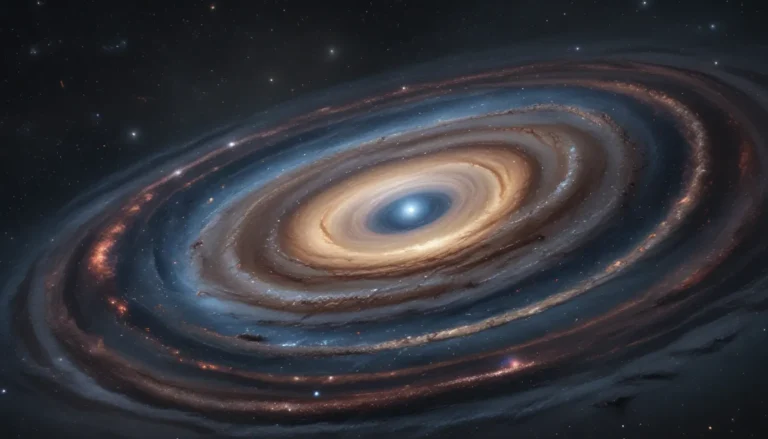The pictures we use in our articles might not show exactly what the words say. We choose these pictures to make you interested in reading more. The pictures work together with the words but don’t take their place. The words still tell you the important facts.
Have you ever looked up at the night sky and wondered about the invisible particles that constantly bombard our planet from deep space? These mysterious entities, known as cosmic rays, are powerful high-energy particles that have captivated scientists for decades. From their origins in supernovae to their role in the formation of the universe, cosmic rays are a fascinating subject of study in the field of cosmic ray astrophysics.
In this article, we will explore 19 astounding facts about cosmic ray astrophysics that will leave you in awe of the cosmic rays that surround us. We will unravel the mysteries surrounding their composition, origins, and impact on the cosmos. So strap in and prepare to embark on an exhilarating journey through the realm of cosmic rays!
Unraveling the Secrets of Cosmic Rays
- Cosmic rays are powerful high-energy particles from space that bombard Earth, posing risks to astronauts and offering clues about the Universe's magnetic fields and dark matter. By studying cosmic rays, scientists can unveil the mysteries of the cosmos, from understanding the origins of these energetic particles to exploring the fundamental properties of particles and their impact on our planet.
The Intriguing Nature of Cosmic Rays
Cosmic rays are high-energy particles made up of protons, electrons, and atomic nuclei that originate from various cosmic sources such as supernovae, black holes, and even distant galaxies. These particles have incredibly high energies, with some cosmic rays possessing energies millions of times greater than any particle accelerator on Earth can achieve. Despite their sources, cosmic rays constantly bombard Earth from all directions, with an estimated flux of one particle per square centimeter per second.
The Cosmic Impact
While cosmic rays offer a wealth of knowledge about the universe, they can also be harmful to astronauts in space due to their high energy and charged nature. These particles can cause DNA damage and other health issues. However, studying the arrival directions of cosmic rays can provide valuable insights into the magnetic fields present both in our galaxy and beyond.
Exploring Cosmic Ray Phenomena
When cosmic rays interact with Earth's atmosphere, they can create a shower of secondary particles, including muons, neutrinos, and gamma rays. Scientists are also investigating the potential role of cosmic rays in cloud formation by ionizing atmospheric particles, which may impact weather patterns. Studying cosmic rays allows scientists to explore the fundamental properties of particles, such as their mass, charge, and lifetimes. By analyzing the energy spectrum and composition of cosmic rays, astrophysicists can gain insights into their sources and acceleration mechanisms.
Unveiling Cosmic Mysteries
Cosmic rays have a wide range of energies, ranging from lower-energy particles that can be detected on the ground to ultra-high-energy cosmic rays that are incredibly rare. These particles have been observed originating from distant galaxies, providing valuable information about extreme environments beyond our Milky Way. Unlike charged particles from other sources, cosmic rays can travel in straight lines through magnetic fields, allowing them to reach Earth from far-off regions of the universe.
Cosmic Rays and Beyond
In addition to their scientific value, cosmic rays also have practical applications, such as radiography. The penetrating power of cosmic rays enables scientists to study the internal structures of objects and materials. Furthermore, cosmic rays hold the key to unlocking the mysteries of dark matter, a significant component of the universe. By studying the behavior of cosmic rays, scientists hope to gain insights into the nature and properties of dark matter.
Understanding the Impacts of Cosmic Rays
When cosmic rays collide with atomic nuclei in the atmosphere, they can trigger nuclear reactions, leading to the production of new particles and isotopes. However, the charged nature of cosmic rays can also interfere with electronics, causing glitches and errors in sensitive equipment such as spacecraft and satellites. Despite their potential risks, cosmic rays have been studied for over a century, contributing valuable insights into the workings of the universe.
A Glimpse Into the Future
As technology advances, so does our ability to detect and analyze cosmic rays, providing us with a greater understanding of these enigmatic particles that traverse the vastness of space. The study of cosmic ray astrophysics continues to amaze scientists and researchers worldwide, offering glimpses into the mysteries of the universe. By delving into the properties and behavior of cosmic rays, we can expand our understanding of the cosmos and make advancements in various fields such as particle physics, astrobiology, and space exploration.
Conclusion: A Universe of Discovery
Cosmic ray astrophysics is a captivating field that sheds light on the mysteries of the universe. From the origin and propagation of cosmic rays to their interactions with magnetic fields and their impact on space weather, there is still much to learn. As we progress in the study of cosmic rays, we are sure to uncover even more astonishing facts and discoveries waiting to be revealed. With each new revelation, we edge closer to unlocking the secrets of the universe and deepening our appreciation for the wonders that lie beyond our planet.
FAQs
Q: What are cosmic rays?
A: Cosmic rays are high-energy particles, mainly protons and atomic nuclei, originating from sources outside our solar system. They travel at near-light speeds and can produce secondary particles when interacting with Earth's atmosphere.
Q: How are cosmic rays detected?
A: Cosmic rays are detected using various methods, including ground-based detectors, satellite-based detectors, and high-altitude balloon experiments. These detectors measure the energy, direction, and composition of cosmic rays.
Q: What is the origin of cosmic rays?
A: The exact origin of cosmic rays is still under investigation, with possible sources including supernovae, pulsars, black holes, and active galactic nuclei.
Q: Are cosmic rays harmful to humans?
A: Cosmic rays can pose health risks to astronauts in space and airline crew members flying at high altitudes for long durations. However, their impact on human health on Earth's surface is minimal due to atmospheric protection.
Q: How do cosmic rays contribute to our understanding of the universe?
A: Cosmic rays provide valuable insights into the universe by revealing processes in distant cosmic objects, magnetic fields, and conditions in space.
Q: Can cosmic rays affect Earth's climate?
A: While cosmic rays can influence cloud formation, their impact on Earth's climate is still under research and debate among scientists.
Q: How do researchers study cosmic rays?
A: Researchers employ ground-based experiments, satellite observations, and computer simulations to study cosmic rays, gathering data on their particles, energy spectrum, and interactions with various environments.
Cosmic ray astrophysics is just one piece of the cosmic puzzle, offering a glimpse into the vast and mysterious universe. Delve further into the wonders of space by exploring facts about the interstellar medium, magnetic fields, and the power of gamma-ray bursts. Each discovery brings us closer to unraveling the secrets of the cosmos and expanding our knowledge of the universe we call home.
Remember, the pursuit of knowledge is a never-ending journey, and each new fact uncovered adds to the tapestry of our understanding. With each revelation, we step closer to the infinite wonders of the cosmos, deepening our connection to the universe and the mysteries it holds.






